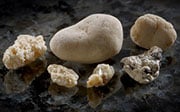
May 23, 2014 — Two studies examining the influences and impacts of kidney stones show ultrasound reduces radiation exposure and is less expensive compared to computed tomography (CT) scans, while a second study indicates better glycemic control in diabetic patients lowers the risk for kidney stone development. Both studies were presented at the 109th annual scientific meeting of the American Urological Association (AUA) in Orlando, Fla.
For patients entering the emergency room with suspected kidney stones, imaging is frequently used to confirm their diagnosis. CT scans have increasingly been used to exclude other diagnoses and confirm urinary stone disease, but are frequently associated with duplicate imaging and increased radiation exposure. Researchers from 15 medical centers across the United States, including University of California, San Francisco, found using CT scans instead of ultrasounds increased radiation exposure and imaging costs but had no significant difference in patient outcome.
Additionally, based on earlier studies that have shown people with type 2 diabetes to have a greater chance of developing kidney stones, researchers with the Cleveland Clinic conducted a study to evaluate the impact of diabetic medications and glycemic control on urine acidity levels and stone composition. Their research showed type 2 diabetics who kept their blood glucose levels as close to normal as possible had a decreased risk of developing kidney stones versus those who did not maintain their blood sugar levels.
"Enhancing patient safety and lowering incidence of disease in higher-risk patients are major priorities within the medical community," said Margaret Pearle, M.D., Ph.D., professor of urology at the University of Texas Southwestern Medical Center and the Mineral Metabolism Center. "Understanding how to prevent kidney stones combined with further evaluation of the methods used to detect and treat them can only increase the quality of care we strive to deliver patients every day."
Researchers conducted a randomized comparative effectiveness trial of data received from 15 medical center emergency departments with patients who came in exhibiting kidney stone-like symptoms. Patients aged 18 to 75 years of age were randomly assigned either an ultrasound or a CT scan as their initial diagnostic test. Subsequent medical management, including receipt of additional imaging, was performed at the discretion of the patients' physicians. The incidence of serious adverse events diagnosed within 30 days, cumulative radiation exposure and imaging costs during the subsequent six months were compared. Secondary outcomes, including pain and return emergency room visits and hospitalizations were also measured.
Results showed:
- Average cumulative radiation exposures were significantly higher for those who received a CT scan (17.5 mSv) compared to those who received an ultrasound from an emergency room physician (10.5 mSv) or radiologist (9.3 mSv).
- Average imaging costs were higher for those patients who received a CT scan ($300) than those who received an ultrasound performed by an emergency room physician ($150) or a radiologist ($200).
- Serious adverse events occurred in 106 of 958 patients (11.1 percent) who received a CT scan versus 112 of 908 patients (12.3 percent) who received an ultrasound from an emergency room physician. The same events occurred in 95 of 893 patients (10.6 percent) who received an ultrasound from a radiologist.
Investigators concluded the use of ultrasound as part of the initial evaluation of patients with suspected kidney stones was associated with lower cumulative radiation exposure and imaging costs than that of CT scans. Additionally, there was no significant difference in the risk of subsequent serious adverse events, pain resolution, return emergency room visits or hospitalizations.
In the other study, researchers conducted a retrospective review of patient data collected from July 2002 through January 2013 for type 2 diabetic patients with kidney stones. Data recorded from 1,831 type 2 diabetic patients with stone disease comprised age, gender, body mass index (BMI), glycosylated hemoglobin level (HbA1c), all diabetes-related medications (insulin and oral), all stone-related medications (i.e. allopurinol, potassium citrate, vitamin B6, thiazide), urine pH, 24-hour urine stone risk profiles, and stone composition. Patients were divided into two groups according to their diabetic medications (n=375 insulin group, n=1,456 antihyperglycemics group), and then compared according to urine collections and stone composition. A linear regression was performed to assess which variables could predict a low urine pH. Additionally, a subgroup analysis compared patients on thiazolidinediones (i.e. pioglitazone) to those on other oral antihyperglycemics (anti-diabetic medications).
Results showed:
- Male gender and insulin therapy were identified as protective factors of low urine pH, while HbA1c was inversely related to the acid levels in the urine.
- No significant differences were found in other 24-hour urine stone risk parameters or stone composition between the two groups.
- In the subgroup analysis, there were no significant differences between patients who were receiving thiazolidinediones compared to other oral antihyperglycemics.
Results concluded the level of acid in urine is inversely related to blood sugar levels. Findings also concluded insulin therapy is associated with higher levels of acid in the urine compared to that of oral anti-diabetic medications; therefore, tighter glycemic control may decrease the risk of kidney stones.
For more information: www.auanet.org


 April 12, 2024
April 12, 2024 








